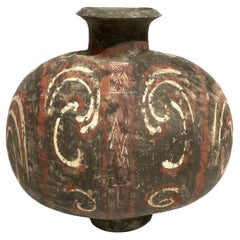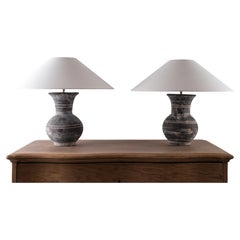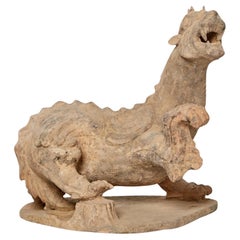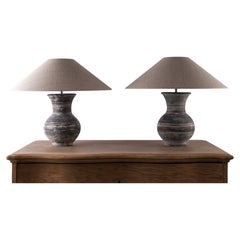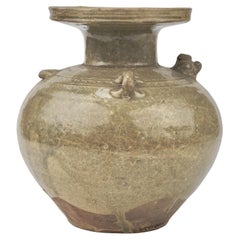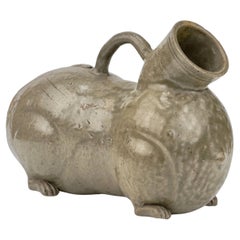Han Furniture
15
117
5
to
14
84
16
122
122
122
192,686
116,580
41,810
32,235
15,104
11,553
10,382
10,228
9,433
8,674
7,258
7,121
6,242
5,876
5,598
5,185
4,632
3,536
89
7
21
5
3
7
3
1
94
38
34
16
13
118
115
110
4
1
1
Style: Han
Han Dynasty Pottery Mythical Bixie Beast TL Tested
Located in Dallas, TX
A Large Chinese Pottery Mythical Creature Figure from the Han Dynasty
China. Western Han Dynasty Circa 25 - 220
TL tested estimated age 1800 years old (+/- 200) by Artemis Testing ...
Category
15th Century and Earlier Chinese Antique Han Furniture
Materials
Pottery
Pair of Han Style Lamp with Handmade Belgian Linen Shades
Located in Jesteburg, DE
A beautiful pair of unglazed Han dynasty style vases of very elegant baluster form.
Expectedly mounted as lamps. High quality mount with a brass adjustable pivot joint. Shade handmad...
Category
21st Century and Contemporary Chinese Han Furniture
Materials
Pottery
Chinese Song Dynasty Blue Glazed Foo Dog Lion Incense Burner Figure
Located in Forney, TX
A rare and remarkable original Song (Sung) Dynasty (960 to 1279) dark turquoise blue glazed earthenware pottery joss stick incense holder. Likely Jun ware, Northern Song Dynasty (960...
Category
15th Century and Earlier Chinese Antique Han Furniture
Materials
Earthenware, Pottery
Rare Yue Celadon Chicken-Head Ewer, Jin-Southern Dynasty
Located in seoul, KR
Chicken-head celadon is among the most distinct and emblematic piece from the dynamic yet innovative era spanning from the Han (206 BC - AD 220) to the Tang (618-907) dynasties. Thei...
Category
15th Century and Earlier Chinese Antique Han Furniture
Materials
Celadon
Rare Yue Celadon-Glazed Figural Vessel, Western Jin dynasty (265-420)
Located in seoul, KR
This vessel is well-modeled as a recumbent winged lion with detailed decorative elements. It features a grimacing face with large protruberant eyes under heavy brows and a gaping mou...
Category
15th Century and Earlier Chinese Antique Han Furniture
Materials
Celadon
A Green-Glazed Stoneware Jar (Hu Vessel), Han Dynasty
Located in seoul, KR
Ovoid form escalating to a cylindrical neck with a flaring rim, adorned at the shoulder with three narrow grooved horizontal bands. Each side is equipped with an incised double-loop handle, culminating in an ornate scroll motif at the top and a fluted ring at the bottom. Wave patterns are meticulously incised along the neck and rim. The upper portion of the body and the inner rim are enveloped in a translucent olive-green glaze.
Period : Han Dynasty (206 BC - 220 AD)
Type : Jar
Medium : Stoneware
Dimension : 34cm(Height) x 15cm(Mouth Diameter)
Provenance : The piece was acquired in Hong Kong in the late 1990s.
Condition : Excellent (Wear consistent with age)
Reference :
1) Sotheby's New York 17 March 2015 - Chinese Art Through The Eye Of Sakamoto Gorō – Ceramics...
Category
15th Century and Earlier Chinese Antique Han Furniture
Materials
Stoneware
Large Yue Globular Stoneware Jar, Han Dynasty-Three Kingdoms
Located in seoul, KR
Robustly crafted with a voluminous spherical body and a layered mouth rim, this jar features a pair of taotie handles. It is adorned with three horizontal bands on the upper half of the olive-green-glazed body, which segment the glazed area into three distinct parts. The top section boasts an incised wave pattern, while the unglazed lower body presents a light brown hue.
Period : Han Dynasty (206 BC - 280 AD)
Type : Jar
Medium : Stoneware
Dimension : 31cm(Height) x 11cm(Mouth Diameter) x 32cm(Diameter)
Provenance : The piece was acquired in Hong Kong in the late 1990s.
Condition : Excellent (Wear consistent with age)
Reference :
1) MIA - Accession Number 98.214.2
(Type : Highly related)
2) Sotheby's New York 17 March 2015 - Chinese Art Through The Eye Of Sakamoto Gorō – Ceramics...
Category
15th Century and Earlier Chinese Antique Han Furniture
Materials
Stoneware
Rare Pottery Rectangular Brazier with cicadas in Green Glaze, Han Dynasty
Located in seoul, KR
This pottery brazier, a burial artifact from the Han Dynasty, features quadrilateral sides that slope inward and a base with slits for ventilation. Each side is adorned with animal m...
Category
15th Century and Earlier Chinese Antique Han Furniture
Materials
Pottery
Han Dynasty Earthenware Cocoon Jar
Located in Dallas, TX
Chinese Han Dynasty earthenware cocoon jar
Cocoon jars or Cocoon-shaped jars are funerary pottery vessels in China, belonging to the period of the 1st millennium BCE. The shape is s...
Category
15th Century and Earlier Chinese Antique Han Furniture
Materials
Pottery
Han Dynasty Earthenware Cocoon Jar
Located in Dallas, TX
Chinese Han Dynasty earthenware cocoon jar
Cocoon jars or Cocoon-shaped jars are funerary pottery vessels in China, belonging to the period of the 1st millennium BCE. The shape is s...
Category
15th Century and Earlier Chinese Antique Han Furniture
Materials
Pottery
Apsara Carved Limestone Stele with Extremely Rare 'Oolitic silica', Wei Dynasty
Located in seoul, KR
The small dots apparent on the surface of this stone stele are indicative of an oolitic silica structure or oolites formed in what is known as "Oolitic chert." This formation occurs gradually over the course of thousands to several hundred thousand years within the soil or sea. Similar structures are commonly found in ancient fossils or arrowheads. Ancient peoples chose certain types of stones for tool-making, preferring materials that were easier to work with and could be sharpened effectively. This predilection is believed to be the reason why oolitic silica structures are frequently found in ancient arrowheads.
The development of these oolitic silica structures is a very slow process involving the accumulation of siliceous layers around particulates. This phenomenon, where silica reacts with water to form layers around a nucleus, occurs under specific chemical and physical conditions. Typically, it takes thousands to hundreds of thousands of years for silica to gradually accumulate in layers through contact with moisture, a process that requires a precise harmony of many variables, including chemical conditions, temperature, pressure, pH, and biological activity.
It is known that no other stele with such a silica structure has been identified to date, serving not only as evidence of its authenticity but also significantly enhancing the rarity of this piece.
This stele appears to be a stone sculpture of an apsara, a celestial nymph from Buddhist and Hindu traditions. Despite its fragmentary state, the sculpture conveys grace and movement. The apsara is captured in a dynamic pose, perhaps once part of a larger tableau, playing a flute-like instrument.
Date : Northern Wei/Eastern Wei Dynasty(386~550)
Size : 22cm (Height) x 16cm(diameter)
Condition : Good (oolites dots on surface)
Provenance : Acquired in late 1990s from Hongkong
Reference :
1) Sotheby's New York 20 March 2018 - Jingyatang Treasures Of Chinese Buddhist...
Category
15th Century and Earlier Chinese Antique Han Furniture
Materials
Stone, Limestone
Milling Shed pottery with Green Glaze, Eastern Han Dynasty
Located in seoul, KR
Made from the standard orange earthenware body of Han green glazed tomb models, this miniature milling station features a circular millstone and a foot...
Category
15th Century and Earlier Chinese Antique Han Furniture
Materials
Earthenware, Pottery
Rare Yue Celadon Chicken-Head Ewer, Jin-Southern Dynasty
Located in seoul, KR
Chicken-head ewers are among the most distinct and emblematic pottery pieces from the dynamic yet innovative era spanning from the Han (206 BC - AD 220) to the Tang (618~907) dynasti...
Category
15th Century and Earlier Chinese Antique Han Furniture
Materials
Celadon, Stoneware
Vintage Han Dynasty Style Cast Iron Horse Sculpture on Wood Base 21"
Located in Dayton, OH
20th century cast iron sculpture or hitching post of a Han (or Tang) Dynasty style horse with muscular cheeks, open mouth and no legs. Mounted on a hollow, dovetailed, un-finished wo...
Category
20th Century Han Furniture
Materials
Iron
Rare Yue Celadon-Glazed Vessel, Jin dynasty (265-420)
Located in seoul, KR
A Yue celadon vessel from the Jin Dynasty period, notable for its characteristic greenish-glazed pottery which was prominent during this time. The vessel features a globular body wit...
Category
15th Century and Earlier Chinese Antique Han Furniture
Materials
Stoneware
Green-glazed pottery lampstand, Han Dynasty(206BC-220AD)
Located in seoul, KR
The upper section of the vessel is broad and flat, intended to support a candle or an oil lamp, while the stem and base are robust, designed for stability and durability. The surface...
Category
15th Century and Earlier Chinese Antique Han Furniture
Materials
Earthenware
Guardian(Half human half beast) Pottery Figure, Northern Wei-Tang Dynasty
Located in seoul, KR
This guardian figure represents a fusion of human and beast, a common motif symbolizing protection in Chinese lore. Crafted from pottery, the figure is a testament to the era's sculp...
Category
15th Century and Earlier Chinese Antique Han Furniture
Materials
Pottery
Heavenly Beings Carved Limestone Stele Fragment, Northern/Eastern Wei Dynasty
Located in seoul, KR
Flying two heavenly beings depicted in the stone. They are celestial beings called an Apsara. While having the same fragment and shape, another work I uploaded exhibits small dots on...
Category
15th Century and Earlier Chinese Antique Han Furniture
Materials
Limestone
Rare Boshan Incense Burner Yue Celadon, Jin dynasty
Located in seoul, KR
The Boshan incense burner is particularly notable among Han dynasty incense burners for its unique shape. Designed to resemble a mountain or even a mythical mountain, it is characterized by its pointed peaks that rise upwards. These peaks often function as vents for the smoke, creating an effect reminiscent of a volcanic eruption.
The body of the incense burner is typically round, with multiple small peaks surrounding a central, larger peak. The material used is mainly ceramic, although there are instances where they were made of bronze. It is presumed that this incense burner was used for religious or ceremonial purposes during its time. The colors of these burners are usually in shades of pale green or greyish brown, with the application of glaze to achieve a variety of colors on occasion.
Such incense burners are often found in tombs or ritual sites, and their purpose was to burn incense for purification of space or to produce pleasant aromas. The Boshan incense burner also represents a significant cultural heritage, showcasing the craftsmanship and artistic values of the period. Today, it is considered a quintessential example of ancient Chinese art.
Period : Han-Jin Dynasty
Type : Incense Burner
Medium : Yue celadon...
Category
15th Century and Earlier Chinese Antique Han Furniture
Materials
Stoneware
Green-Glazed Tripod Vessel, Han Dynasty
Located in seoul, KR
Han Dynasty green-glazed tripods are comparatively rare, especially ones that have retained their structural integrity and glaze over millennia. Pieces in good condition are scarce b...
Category
15th Century and Earlier Chinese Antique Han Furniture
Materials
Earthenware
Large Chinese Painted Pottery Horse Torso, Han Dynasty, China
Located in Austin, TX
A large Chinese painted pottery figure of a horse torso, Han Dynasty (206 BC to 220 AD).
An unusually large Chinese Han Dynasty horse torso, also sometimes referred to as a recumben...
Category
15th Century and Earlier Chinese Antique Han Furniture
Materials
Pottery
Single Han Style Lamp with Handmade Belgian Linen Shade
Located in Jesteburg, DE
A beautiful unglazed Han dynasty style vase of a very elegant form.
Expectedly mounted as lamp. High quality mount with a brass adjustable pivot joint. Shade handmade in Belgium.
T...
Category
21st Century and Contemporary Chinese Han Furniture
Materials
Pottery
Green-Glazed Dish, Han Dynasty
Located in seoul, KR
This Han Dynasty green-glazed dish exhibits significant signs of wear, indicative of its age and the long passage of time it has witnessed. The glaze, once vibrant, now shows substan...
Category
15th Century and Earlier Chinese Antique Han Furniture
Materials
Earthenware
Green-glazed pottery 'figural' lamp, Han Dynasty
Located in seoul, KR
The lamp shaped as a kneeling female figure wearing long robes, her face with a large nose, deep-set eyes and pronounced cheeks, holding an infant in her lap, her cylindrical and elo...
Category
15th Century and Earlier Chinese Antique Han Furniture
Materials
Earthenware
Pair Of Terracotta Brick With Trace Of Polychromy - Style: Han - Period: XIXth
Located in CRÉTEIL, FR
Pair of terracotta bricks with traces of polychromy representing for one a character driving his chariot drawn by a horse and for the other a character training his horse.
These two...
Category
19th Century Asian Antique Han Furniture
Materials
Terracotta
A Rare 'Yue' Celadon Glazed Octagonal Vase, Western Jin Dynasty (266 - 316 AD)
Located in seoul, KR
Finely potted with incurved facetted sides divided by raised ribs and set with two short lugs to the shoulder, the body rising to a short octagonal neck, the domed cover of conforming section, surrounded by an upturned rim and surmounted by a bud finial, applied overall with a celadon glaze of the period.
A related vase of this rare and charming form, in the Zhenjiang Museum, Zhenjiang, is illustrated in the Complete Collection of Chinese Ceramics. Song, vol. 8, Shanghai, 1999, pl. 52. Vases of related octagonal shape were produced at the Ding kilns, in Hebei province, and the qingbai kilns in Jiangxi province; see a Ding vase in the Palace Museum, Beijing, illustrated in Selection of Ding Ware. The Palace Museum’s Collection and Archaeological Excavation, Beijing, 2002, pl. 37; and a qingbai example, from the Meiyintang collection, illustrated in Regina Krahl, Chinese Ceramics from the Meiyintang Collection, vol. 3 (II), London, 2006, pl. 1590; and another carved with a floral scroll, included in the exhibition Song Ceramics from the Kwan Collection, Hong Kong Museum of Art, Hong Kong, 1994, cat. no. 105.
Period : Western Jin Dynasty (266 - 316 AD)
Type : Octagonal Vase
Medium : Yue celadon...
Category
15th Century and Earlier Chinese Antique Han Furniture
Materials
Celadon
Hu Shape Green-Glazed Vase, Han Dynasty(206 BC - 220 AD)
Located in seoul, KR
A 'Hu' is a type of large jar or pot that was commonly used in China for storage purposes, including holding liquids or dry goods like grains. This particular shape of pottery usually features a wide body and a narrow opening, and sometimes comes with a lid. The 'Hu' could also be more elongated with a slender neck, designed for easy pouring of liquids.
The rainbow-like colors on this green-glazed surface come from changes that happen over hundreds of years while it's buried. This process is also known as "iridescence" and is often observed in ancient Chinese green pottery...
Category
15th Century and Earlier Chinese Antique Han Furniture
Materials
Earthenware
Green-glazed pottery tripod 'hill' jar, Han Dynasty, 206 BC - 220 AD
Located in seoul, KR
The modelled animal figures and landscapes of this piece represent the Daoist ideology of the Han dynasty. The mountain-shaped lid refers to the sacred dwellings of the immortals, th...
Category
15th Century and Earlier Chinese Antique Han Furniture
Materials
Stoneware
Cocoon-shaped earthenware jar with cloud-scroll design, West Han Dynasty
Located in seoul, KR
This yellow handsome jar with excellent condition would have served as a mortuary object (mingqi), placed in a tomb as a substitute for the more valuable bronze and lacquer vessels u...
Category
15th Century and Earlier Chinese Antique Han Furniture
Materials
Stoneware
A Han (206BC -220AD) Glazed Hu Vessel
Located in Chicago, IL
This is a fine, heavily patinated example of a Han hu wine storage vessel, buried for the afterlife. The compressed globular body narrows to a slender waisted neck, covered with a da...
Category
15th Century and Earlier Chinese Antique Han Furniture
Materials
Terracotta
Han Style Sandcolor Vase Table Lamp
Located in Vosselaar, BE
A Chinese Han style vase turned in to a tablelamp. Made from unglazed grey earthenware in a pot shape with subtle sandgrain patina. This vase has a grea...
Category
19th Century Chinese Antique Han Furniture
Materials
Earthenware
Western Han Painted Grey Earthenware Standing Female Tomb Figure
Located in Point Richmond, CA
Chinese Painted Grey Earthenware Standing Female Tomb Figure, Western Han Dynasty.
The tall slender court lady stands with knees and elbows slightly bent to reveal the hands, now lost with sockets remaining. The detachable rounded head has a delicately modeled face with small features and painted accents. The neck serves as an extended plug into the neckline of the hollow body ata slight cant as if eyes are downcast and bowing. The hair full at the hairline in form and painted black continuing on the back of the body on center to the waist. The body form of draped layers of long robes, crossing left over right over sloping shoulders with a stiff collar, deep full sleeves tied with a sash low on the waist and trumpet flared at the base, all outlined in red, white and black pigments. Custom black silk storage box in Chinese hinged lid style.
Weight: 15.5 lbs.
Western Han Dynasty 206 B.C. - A.D. 9
Thermoluminescence testing of head and body with Bortolot Daybreak Corporation, Guilford, CT, 1989 sample #379A1. Date of firing 2300 +/- 600 years ago.
Provenance:
Upon Request
For similar examples see:
Oriental Ceramics, The World’s Great Collections, The Freer Gallery of Art, Washington D.C., Vol. 9, 1975, pl. 8 & 9.
Mayuyama, Seventy Years, Vol. 1, 1976 p.53, pl.123
Sotheby’s New York, The Bernat Collection, November 1980, lot # 19. With hands covered and folded in front of the figure.
Yutaka Mino and James Robinson, Beauty and Tranquility: The Eli Lilly...
Category
15th Century and Earlier Chinese Antique Han Furniture
Materials
Clay
Sichuan Burnished Black Han Dynasty Pottery Amphora Vase
Located in London, GB
Sichuan Burnished Black Han Dynasty Pottery Amphora Vase
Of pear form with a vertically incised band around the neck beneath a lozenge-shaped open...
Category
15th Century and Earlier Chinese Antique Han Furniture
Materials
Pottery
Chinese Han Dynasty Standing Cowled Lady, Gray Pottery, 202 BC - 9 AD, China
Located in Austin, TX
A tall and dramatic Chinese high fired gray pottery model of a standing lady wearing a hood and a flared skirt, Western Han Dynasty (202 BCE - 9 CE), Shaanxi, China.
This striking ...
Category
15th Century and Earlier Chinese Antique Han Furniture
Materials
Earthenware, Pottery
Round Handmade and Painted Chinese Terracotta Ding-Style Vessel
Located in Houston, TX
Round handmade and painted Chinese terracotta ding-style vessel with lid. Tripod footed base. Vessel is antique, probably Han, but original paint wore and the current finish is recen...
Category
15th Century and Earlier Chinese Antique Han Furniture
Materials
Ceramic, Earthenware, Terracotta, Paint
Han Dynasty Horse Sculpture, 206BC- 209 AD
Located in Tunbridge Wells, GB
Han Dynasty Horse Sculpture, 206BC- 209 AD
It is interetsing to note the position of the riders feet. They are gripping the shoulder of the horse. D...
Category
15th Century and Earlier Chinese Antique Han Furniture
Materials
Pottery
Large Han Dynasty Hu Green Glazed Mythical Beasts Vessel
Located in Dallas, TX
A large and decorative Chinese green-glazed pottery hu vase.
Han dynasty (206 BC - 220 AD).
The compressed globular body encircled by eight mystical beasts of monkeys, Rabbits, de...
Category
15th Century and Earlier Chinese Antique Han Furniture
Materials
Pottery
Korean Mid Century Mabeyong Vase in white, greens, red, orange and black
Located in Lomita, CA
The hand painting of this vase is intricate and detailed and is typical of
a Maebyeong or Korean Baluster vase, unsigned and unmarked, but based on the decorations, it looks mid 20t...
Category
Mid-20th Century Korean Han Furniture
Materials
Ceramic
19th Century Korean Two Part Elm Chest Each Finished off with Brass Adornments
Located in High Wycombe, GB
19th century korean two part elm chest each finished off with brass adornments on a sleigh base.
Composed of two parts
Additional dimensions
Measures: Height: 92cm I width...
Category
19th Century Korean Antique Han Furniture
Materials
Brass
Chinese Cocoon Jar, Burnished Gray Pottery, Western Han Dynasty, China
Located in Austin, TX
A classic Chinese Han Dynasty "cocoon jar" of high fired burnished gray pottery, Western Han Dynasty (206 BC - 9 AD), China.
The jar of typical form, w...
Category
15th Century and Earlier Chinese Antique Han Furniture
Materials
Pottery
China 100 BC Han Dynasty Ancient Rare Stickman Sculpture in Earthenware Pottery
Located in Miami, FL
Standing Stickman from the Han Dynasty.
Original ancient Chinese tomb attendants sculpture of a tall, thin standing man wearing a short tunic. Beautifully crafted in grey earthenw...
Category
15th Century and Earlier Chinese Antique Han Furniture
Materials
Iron
Han Dynasty Pottery Horse and Rider
Located in Dallas, TX
Han Dynasty painted pottery horse and rider
A Chinese Han Dynasty painted pottery horse & rider. Made from grey pottery and cold-painted in white, red and black pigments. The rider dressed as a warrior and in the pose of holding reins for the horse. Comes with a custom sturdy lucite stand.
Measures: Height: 13.5 inches (33cm).
Length: 13 inches
Depth: 5 inches
Han Dynasty (206 BC – AD 220).
Condition: Very good with past restoration to legs.
The great influence of the horse throughout the history of China can...
Category
15th Century and Earlier Chinese Antique Han Furniture
Materials
Pottery
Han Dynasty Glazed Hill Jar
Located in Dallas, TX
Han earthenware celedon glazed hill jar
The hill jar represents the five sacred mountains which is the path between the earth and Paradise. The mountains are...
Category
15th Century and Earlier Chinese Antique Han Furniture
Materials
Pottery
Pair of Han Dynasty Horse Heads (206BC - 220AD) Attributed
Located in Dallas, TX
Pair of Chinese Han dynasty horse heads
Han dynasty (206 BC-220 AD) earthenware gray pottery
Each approx.: 6.25 inches high. 6.5 inches wide. 2...
Category
15th Century and Earlier Chinese Antique Han Furniture
Materials
Pottery
Antique Terracotta Chinese Figures Statues
Located in Alessandria, Piemonte
Antique terracotta figures Han style from my private collection: collected about 35 years ago and never exibited to the public. A certificate Oxford test would be needed: I don't have it, so I'm accepting offers: I want to close my activities and I have a beautiful Chinese collection, see the other ones published under my name enrica pasino.
Category
15th Century and Earlier Chinese Antique Han Furniture
Materials
Terracotta
Han Dynasty Pottery Sculpture of a Winged Lion Mythical Beast
Located in Dallas, TX
A Large Han Dynasty Terracotta sculpture of a Mythical Beast.
Possibly a horned tiger but most probably a winged lion often seen in ancient jade sculptures. I cant emphasize how ra...
Category
15th Century and Earlier Chinese Antique Han Furniture
Materials
Pottery
19th Century Chinese Black Lacquered Five Section Stacking Chest
Located in High Wycombe, GB
19th century Chinese black lacquered five section stacking chest with exquisite figural decorative scenes.
Category
19th Century Chinese Antique Han Furniture
Materials
Lacquer, Paint
Han Dynasty Polychromed Horse and Rider
Located in Dallas, TX
A fine Han dynasty polychrome painted terracotta horse and rider. The warrior is dressed in orange and black on a black horse.
Measures: Height 14 inches (35 cm)
Width 12.5 inches (32 cm).
Condition: Excellent with tastefully undetectable repairs.
During the unification of China under the Han dynasty, bands of mounted nomadic warriors from the north threatened the country. In order to thwart their attacks, the Chinese sought to import stronger, faster steeds from Central Asia (as opposed to the Mongol ponies used by the invaders), eventually leading to the creation of the Silk Road. This small sculpture of a mounted soldier reveals the crucial military role of the horse. When compared to the diminutive stature of the rider, the importance of the horse becomes readily apparent. This creature provided security and strength, allowing the empire to secure its borders and expand its influences across Central Asia. The magnificent regalia of the horse, including a brilliantly painted saddle in red and green/gold, reflect the respect this animal received. The warrior as well is gorgeously decorated with a painted red tunic and gray chest...
Category
15th Century and Earlier Chinese Antique Han Furniture
Materials
Terracotta
Chinese Gilt Metal Drum-Shaped Garden Stool
Located in New York, NY
Chinese gilt metal drum-form garden seat with a band of circular studs around the top and bottom and an incised decorative yin and yang symbol.
Category
20th Century Chinese Han Furniture
Materials
Metal
Han Dynasty Stick Figure from Xian
Located in Santa Monica, CA
This Han pottery figure of a foot soldier is molded and engraved with facial details. It has been fired at high temperatures. The color pigments are painte...
Category
15th Century and Earlier Chinese Antique Han Furniture
Materials
Terracotta
Han Dynasty Horse and Rider
Located in Santa Monica, CA
Han Equestrian 12H.
This equestrian represents the standard of Western Han equestrian found in Yang Jiawan of Xian. The technique of making includes molding, engraving and cold pain...
Category
15th Century and Earlier Chinese Antique Han Furniture
Materials
Pottery
Large Han Dynasty Pottery Sculpture of a Dog
Located in Dallas, TX
Han Dynasty life size Terracotta sculpture of a dog.
Buried in a tomb for thousands of years; this mingqi companion has decided to come back and accompany the living. I’m actually taking a liking to this pup; most probably a fierce pit bull...
Category
15th Century and Earlier Chinese Antique Han Furniture
Materials
Terracotta
Han Dynasty, Laying Doe Wood Sculpture, China 100AD
Located in PARIS, FR
Superb sculpture of a laying doe from the Chinese Han Dynasty (206BC-220AD). Remainders of polychromic paint, namely red, symbol of good fortune and joy as well as the season of summer, and green, symbol of vigor and vitality and the season of spring. Mounted on base.
A similar sculpture in bronze is kept at the Met Museum with the following description " A low bed, small table, and screen were often the only furnishings in a Han-dynasty room. The floors were generally covered with mats kept in place with weights in the shape of single animals, fighting beasts, or entertainers."
Condition seen in pictures.
Dimensions in cm ( H x L x l ) :
- Sculpture : 35 x 40 x 10
- With base : 45.5 x 44 x 15
The Han Dynasty ruled China from 206 B.C. to 220 A.D. and was the second imperial dynasty of China. It is known for its promotion of Confucianism as the state religion and opening the Silk Road trade route to Europe, permanently altering the course of Chinese history. Han Dynasty art and inventions like paper still influence the world today.
From the Han Dynasty to the present, deer can be found in many materials and media—rock crystal, nephrite, ink on paper, porcelain, cloisonné enamel, jade, bamboo root, textile, bronze, etc.—alone or in groups, among trees and rocks and in various positions. They appear on everyday objects, from boxes to incense burners, incense holders, lamps, mirror holders and the droppers scholars used when they wrote. A symbol of longevity and grace in Chinese mythology, the word deer is pronounced lu, a homonym for emoluments—favors granted to officials. They therefore represent wealth, nobility and success in imperial examinations (civil service exams for selecting candidates for the state bureaucracy in Imperial China).
Deer were the faithful companions of Shu Lao, the god of longevity, and the goddess Magu. They were reputed to live long and to be the only creature able to find the mushroom of immortality, linghzhi. Although its spots are different, deer are sometimes confused or associated with stags, a Manchu hunting trophy whose antlers served to make prestigious furniture. (La Gazette Drouot, Claire Papon)
For the colours found on this piece, in Chinese culture, red symbolizes good fortune and joy. Green, symbolizes the spring when everything is brimming over with vigor and vitality.
The Han Dynasty (206 B.C. to 220 A.D.) continued the Qin Dynasty’s use of dark colours, but incorporated red. During the earlier years, or Western Han Dynasty, ordinary people wore red while court dress was black. Shoes were red in color. The clothing worn for sacrificial rites was black edged with red. In the later Eastern Han Dynasty, red symbolized the dynasty’s “fire Virtue” and became predominant. Court dress was red. Sacrificial rites called for a red-edged white layer under robes with red socks...
Category
15th Century and Earlier Chinese Antique Han Furniture
Materials
Wood
Chinese Han Dynasty Large Unglazed Jar with Taotie Masks Mounted as Table Lamp
Located in Wichita, KS
A Chinese Han Dynasty large unglazed terracotta jar, 'Hu,' with Taotie masks that has been mounted as a table lamp. Unglazed pottery like this dates to the Han Dynasty (206 BC-220 AD...
Category
15th Century and Earlier Chinese Antique Han Furniture
Materials
Ceramic, Terracotta, Linen
19th Century Terracotta Duck Form Sculptures
Located in Los Angeles, CA
Nice examples of Han Dynasty style terracotta duck bottles. No breaks. No chips. No repairs. Paint has worn over the years.
Category
Late 19th Century Chinese Antique Han Furniture
Materials
Terracotta, Paint
Chinese Han Dynasty Unglazed Vase with Taotie Masks Mounted as Table Lamp
Located in Wichita, KS
A Chinese Han Dynasty large unglazed terracotta jar, 'Hu,' with Taotie masks that has been mounted as a table lamp. Unglazed pottery like this dates to the Han dynasty (206 BC-220 AD...
Category
15th Century and Earlier Chinese Antique Han Furniture
Materials
Terracotta
Large Han Dynasty Terra-cotta Court Lady Figure TL Tested
Located in Dallas, TX
Huge Han Dynasty Terracotta figure Of A Court Lady. TL Test conducted by Ralf Kotalla Laboratory in Germany. Report included.
Height: 29...
Category
15th Century and Earlier Chinese Antique Han Furniture
Materials
Terracotta
Pair of Han Dynasty pottery Horses and Equestrian Riders
By Émile Gallé
Located in Dallas, TX
A wonderful pair of Ex Sotheby’s painted Polychrome equestrian horse and riders made from gray pottery, presents beautifully and guaranteed authentic with provenance and COA.
Measures: Height 11.5 inches and width 11 inches
Condition: Possible professional restorations but not detectable.
Provenance: Sotheby’s London. 16th November, 1999. Lot 12 (2 of 4 horsed in that lot)
Sotheby’s New York, NY September 14, 2019.
AVANTIQUES is dedicated to providing an exclusive curated collection of Fine Arts, Paintings, Bronzes, Asian treasures, Art Glass and Antiques. Our inventory represents time-tested investment quality items with everlasting decorative beauty. We look forward to your business and appreciate any reasonable offers. All of our curated items are vetted and guaranteed authentic and as described. Avantiques only deals in original antiques and never reproductions. We stand behind our treasures with a full money back return if the items are not as described.
The importance of the horse in the history and culture of China can be viewed, in part, through the artistic legacy of this great civilization. In sculpture, painting, and literature, horses were glorified and revered. Horses were believed to be related to mythological dragons, reflecting their sacred status within society. During the unification of China under the Han Dynasty, bands of mounted nomadic warriors from the north threatened the country. In order to thwart their attacks, the Chinese sought to import stronger, faster steeds from Central Asia (as opposed to the Mongol ponies used by the invaders), eventually leading to the creation of the Silk Road. This small sculpture of a mounted soldier reveals the crucial military role of the horse. When compared to the diminutive stature of the rider, the importance of the horse becomes readily apparent. This creature provided security and strength, allowing the empire to secure its borders and expand its influences across Central Asia. The magnificent regalia of the horse, including a brilliantly painted saddle in red and green/gold, reflect the respect this animal received. The warrior as well is gorgeously decorated with a painted red tunic and gray chest...
Category
15th Century and Earlier Chinese Antique Han Furniture
Materials
Pottery
Han furniture for sale on 1stDibs.
Find a broad range of unique Han furniture for sale on 1stDibs. Many of these items were first offered in the 21st Century and Contemporary, but contemporary artisans have continued to produce works inspired by this style. If you’re looking to add vintage furniture created in this style to your space, the works available on 1stDibs include asian art and furniture, decorative objects, lighting and other home furnishings, frequently crafted with ceramic, terracotta and other materials. If you’re shopping for used Han furniture made in a specific country, there are Asia, East Asia, and China pieces for sale on 1stDibs. While there are many designers and brands associated with original furniture, popular names associated with this style include and Emile Gallé. It’s true that these talented designers have at times inspired knockoffs, but our experienced specialists have partnered with only top vetted sellers to offer authentic pieces that come with a buyer protection guarantee. Prices for furniture differ depending upon multiple factors, including designer, materials, construction methods, condition and provenance. On 1stDibs, the price for these items starts at $199 and tops out at $195,000 while the average work can sell for $4,800.
Recently Viewed
View AllMore Ways To Browse
Antique Bronze Drawer Pull
Commode Grey
Flower Commode
Four Panel Asian Art
Fine Wood Inlaid Cabinet
Chinese Gilt Panel
Corner Display Cabinet French
Deco Brass Panel
Clocks With Cherubs
Counter Top Display Case
Wood Door Knobs
Curved Glass Door Cabinet
Desk With Return
Chest Of Drawers Leather Top
Classic Buffet
Commodes With Flowers
Antique Chinese Robe
Distressed Antique Brass
